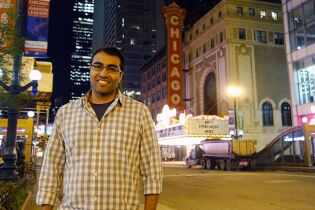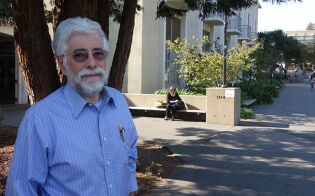
- Has God been tuning the constants of nature? Then he could have done a better job with the precise adjustment, writes astrophysics professor Øystein Elgarøy.
Did somebody tune the natural constants?
# Commentary/Review by astrophysics professor Øystein Elgarøy, University of Oslo Norwegian version published June 6, 2008 The laws of physics includ...
Publisert: 20.06.2008 kl 10:32
Sist oppdatert: 20.06.2008 kl 11:36
Commentary/Review by astrophysics professor Øystein Elgarøy, University of Oslo
Norwegian version published June 6, 2008
The laws of physics include several constants, and a substantial number of these we are unable to calculate by using basic principles as a starting point. They have to be measured. Relevant examples are the force of the four basic natural powers: The force of gravity, electro-magnetic power, weak and strong nuclear energy. Furthermore, we have parameters determining the characteristics of the universe on a large scale and its history, for instance. the average density of the universe.
The laws of physics are applicable, irrespective of the measurement values of these quantities. However, it seems that our existence is dependent on their not being very different from the values we have actually measured. An example: Apparently, the evolution needs a wide time span to generate complicated organisms, typically some billion years, and this would have been impossible on Earth without the energy induced from the sun.
In effect, the requirement has been a star that is stable during several billion years. A stable star during such a long period is dependent on the balance between forces of gravity and electro-magnetic powers. If we make hypothetical star charts, showing the comparative strength between these two powers adjusted with a few percent matched to the original level, we end up with stars that have insufficient life span.
Another very relevant example in present cosmology: Ten years ago, two separate groups of astronomers found clear evidence that the universe is expanding more rapidly than before. Such an accelerating expansion is difficult to understand, because it is the force of gravity that determines how the expansion rate of the universe gradually changes with time. Assuming that the force of gravity is always exerting a pull, the expansion rate ought to decrease. The unproblematic explanation of the result is that the energy budget of the universe is dominated by vacuum energy.
In quantum mechanics an empty space is not completely empty. It is a bubbling sea of particles and antiparticles emerging and disappearing again. These processes give vacuum an energy. And the vacuum energy seems to generate repelling gravity fields. We still do not understand how the vacuum energy is to be calculated theoretically, and quite a few people think that it is impossible to do so: In principle, this is a parameter with arbitrary value.
However, it is possible to establish what value it must have in order to explain the observed acceleration of the universe. Yet again, it turns out that if it had been exceeding what we are able to monitor, then we would not be here. If the vacuum energy were too high, the universe would have expanded too rapidly to enable development of structures like stars and galaxies.
The preliminary conclusion to be drawn from the examples above, is that the parameters determining the kind of universe we live in seem to be finely adjusted in preparation for our existence. The question is whether this can be explained.
One way of explaining this is the so-called "multiverse" chart. A class of charts for the earlier universe predicts that, in addition to our own universe, a number of bubbles of space and time were generated (and they are still being created). Furthermore, the natural constants vary between the different bubbles. In effect, what we call our universe is only one of many in a so-called "multiverse".
If this is correct, the explanation why the natural constants appear to be finely tuned with a view to our existence, does not differ from the explanation why we live on Earth, and not on Jupiter. Intelligent life comes into being in the universe bubbles where the prevailing conditions make it possible.
However, from time to time, the apparent precise tuning of the natural constants is used as a proof of the existence of a "Fine Adjuster" (God).
This argument is presented for instance both in the book "God's Universe" by astronomer Owen Gingrich and in the book "There is a God" by Antony Flew.
Argument table:
- Premise 1: The existence of (intelligent) life in the universe demands that several of the ratios between essential physical quantities (the ratio between the force of gravity and electro-magnetic powers, vacuum energy etc.) have values close to the measurements we take.
- Premise 2: In principle, these quantities might have arbitrary values.
- Premise 3: There is no natural mechanism generating the values measured by us.
- Conclusion: The constants of nature were determined by a supernatural "Fine Adjuster" in preparation for the creation of intelligent beings.
There are several reasons why this argument does not hold water. None of the premises are watertight. Let me deal by them, one by one.
The first premise is, actually, a conclusion drawn prematurely. We know of only one example of intelligent life in the universe, and we have no knowledge of the bio-chemical mechanisms that entailed the creation of life on Earth. This should make us a somewhat careful to draw broad conclusions on how difficult it is for intelligent life to develop.
All studies concluding that the natural constants must be precisely adjusted, takes as a starting point that life will always emerge under similar conditions to those found on Earth. In order to chart the possibilities, in actual fact, all quantities must be varied simultaneously. This is a difficult undertaking, but in the few studies where more than one of the natural constants have been allowed to vary, it has been evident that a universe with the conditions we deem necessary for intelligent life might have natural constants very different from our measurements.
The second premise maintains that the constants of nature must have arbitrary values. This might be the case, but to be on the safe side, we must have a reliable quantum gravity theory. Of course, it is possible that such a theory would be able to explain the values of the fundamental quantities, or, in any case, reduce the number of significant variations.
The "multiverse" hypothesis is an attempt to contend with the third premise. This is, mainly, motivated by a popular chart for the very early universe, a so-called chaotic inflation, predicting that several independent universes, each with its own set of natural constants, would be generated.
This chart also contains predictions that can be tested in our universe, and, actually, has some empirical support. However, if this one is true, then the third premise in the argument above is not correct. In the "multiverse", all viable combinations of values for the different natural constants would be realised in one or another of the members of the "multiverse". Intelligent life will, of course, only be found in the bubbles where the natural constants permit life to emerge. The existence of such life is no more peculiar than the fact that there is (almost) always one or more top winners in the National Lottery. Of course, it is not very likely that I should be the winner, but that somebody is going to win is not that surprising.
Let me add that if the "multiverse" hypothesis often is accused of complexity, this is due to a confusion of the laws of physics with the results of the laws. In this chart, the number of universes must be perceived as separate areas of the underlying time space. The mechanism producing them is based on an uncomplicated, physical chart.
Every day we witness simple laws of nature entailing complex phenomena, and when we talk about uncomplicated physics, we are referring to the natural laws. The "multiverse" might seem complicated, but if it exists, then it is the result of simple principles. Thus, the Theistic argument, that a "Fine Adjuster" is a less intricate hypothesis than the "multiverse", is not correct.
The "multiverse" is often accused of being a non-falsifiable construction, since the other universes, almost by virtue of their construction, lie beyond the part of reality we have access to. This criticism is not well founded. Furthermore, the mechanism creating the "multiverse" has generated our universe, and display visible consequences here. Gradually, as we get better observations, we are able to decide whether chaotic inflation is in conflict with what we see, and, in that case, the "multiverse" hypothesis will suffer a serious defeat.
In physics we sometimes work with objects that are not directly observable. However, we are convinced of their existence, based on the empirical consequences they entail. In this way, the "multiverse" and quarks and atoms are not intrinsically different. Speculations have been made as to the possibility of different universe bubbles colliding from time to time. If this has been the case, visible traces would be discovered in our universe. Even if this may seem very speculative, my point is that it is too early to maintain that the "multiverse" is a non-falsifiable construction,
Finally, I would like to submit what I consider to be a problem for those who make use of the argument for a "Fine Adjuster". If they think that this is a suitable argument for God's existence, they must also accept that life on Earth is the result of an evolution, a blind process without any guarantees of the final consequences.
Thus, they accept that God makes use of natural processes to achieve the result he requires, and that he wants a universe where intelligent life is generated at least in one place. Then, it may be argued that he could have done a better job with the precise adjustment.
Actually, it is not correct that the natural constants and the cosmological parameters must have exactly the observed values in order to permit creation of life. These values may vary within a defined area. If we consider vacuum energy on its own, we might, in fact, increase the chance of creating intelligent life, by making a small adjustment in accordance with the visible value.
If God really did determine the values of the natural constants, he has, in effect, not done an optimal job. Our universe is adequate, but not as satisfactory as it could have been.
Translated by Tone Haugen Jensen
English Vis flere
It was difficult, but this summer "The Friendly Atheist" Hemant Mehta, the man behind one of America's best known atheist blogs, chose to quit teaching to become a full time blogger.
Refutes secularization of the US:
«Growth of the religiously un-affiliated not linked to personal faith»
«They enjoy being obnoxious», American sociologist Claude Fischer says about the new atheists. He also claims religious faith in the US is not declining. (Sept. 16, 2014)






